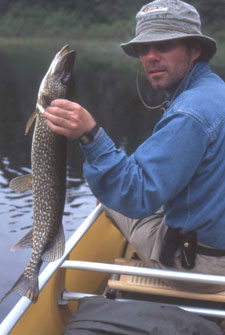
The Challenge
“Dad, get that fish! That’s the biggest pike I ever saw,” Craig yelled at me. A dozen feet from the canoe, a 6- or 7-pound pike swam calmly just under the surface, Craig’s silver Wally Diver along its cheek. Suddenly, the fish lunged toward deep water, jerking free as it did. Craig was crestfallen. “Dad, you didn’t even try to get that fish. That’s the biggest fish I ever hooked and you did not even try,” Craig chided. Craig was 13 at the time, and it was the first time I had taken him with me to Quetico Park in western Ontario. For several years he had listened to my tales of the great adventure and fishing in Quetico Park. On our first evening in the wilderness, he had hooked a big fish and lost it. While Craig moaned, I assured him there would be more pike, perhaps even bigger ones. From his perspective, my assurance was of little value.
Quetico Park abuts Minnesota’s Boundary Waters Canoe Area (BWCA). Like BWCA, Quetico Park is a wilderness area. This is rugged country and not for everyone. Pike anglers who enjoy camping and getting away from hordes of people, however, should find Quetico Park a wonderful experience. Quetico Park is a vast network of lakes and streams linked by portage trails. To get to the interior of the Park, visitors must paddle canoes, carry gear and canoes across portage trails, and camp out in the woods. Firewood has to be gathered, meals cooked, and mosquitoes fought. Anglers who seek “all the comforts of home” need not apply. Among the fish that swim Quetico’s waters, northern pike are common. Outfitters who service Quetico and BWCA regularly have clients who catch 20-pounders. In the 21 trips over 25 years that I have taken, we have caught a couple of bona fide 20-pound pike and lots of fish above 10-pounds. That rate of success with big pike will match all but the best remote fly-in lodges.
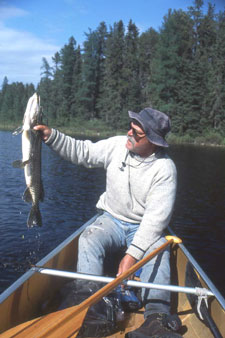
The Spots
Quetico lakes are typical Canadian Shield lakes – deep, clear, and not very fertile. Consequently, vast weed beds that hold pike are pretty rare. Late in the summer – July, August and September – there are patches of broad leave pond weed, called cabbage or pike weed by most pike anglers. As is true across the pike range, these weeds, when found, hold pike.
Some of the lakes have shoreline reed beds. A few years ago Randy Penninger and I found pike along the outer edge of a reed bed. We caught pike like crazy until the wind drove us from the site. In comparable reeds in LeMay Lake, Craig and I caught big pike on our fly rods. At both sites, the pike were scattered along the outside edge of the weeds in 5- or 6-feet of water. Weeds are most likely found in rounded lakes. Examples are Sark, McDougall or Murdoch. These mesotrophic lakes are not as deep as the long narrow oligotrophic lakes like Agnes or Kahshahpiwi. Rooted weeds need relatively shallow water. Weeds, however, may be hard to find. Pike anglers will have to look for other spots. Long rocky points are excellent pike habitat in Quetico Lakes. Most anglers who make it into Quetico Park do not carry depth finders and batteries – too heavy to lug across portage trails. Visual examination of the lakes is critical.
Maps of the Park, an absolute necessity for Quetico travelers, show the outline of the lakes. The points are evident from the maps. Once at the given lake and after camp is set up, pick the “pikeiest “ looking spot and go to it. At one of those points, Randy caught 10-pounders on consecutive casts.
Long, narrow or oblong islands represent the out-of-water portion of reefs or humps that rise off the bottom of the lake. The geological processes that created the island also created the lake substrate. Consequently, the shape and slope of the island provide clues to the shape of the underwater structure. Long, narrow islands have suitable pike habitat at both ends. Deepwater humps are also good pike holding locations, particularly later in the summer. With no topographic maps and no depth finders, contemporary anglers may have trouble finding humps. They are under-fished. Humps may be found by imagining where they might be. That’s not as goofy as it sounds. If several islands are in a row, between the islands and off the ends of the extreme islands in the row are good spots to look. If an island makes a curve or a hook at one end, the hump is likely to be an extension of the curve or hook. On Craig’s first trip we found such a hump off an island in Conmee Lake. It was 100 yards from the side of an island. We found the hump by trolling Wally Divers. When the lures suddenly started bumping the bottom after running free, we knew there was a hump on the bottom. In an afternoon of trolling back-and-forth over the hump, we caught 7- to 10-pound pike and a couple of walleyes each pass over the hump. Sometimes we caught 2 at a time. They were there and nobody fished for them.
Rocky shoals are also good pike habitat in Quetico Park. Where the rocks are visible in the clear water and the shoal then shears off to deeper water is a prime spot. A decade or so ago, Todd Steck was fishing with me as we drifted along a shoal at the northwest corner of Burt Lake. Earlier Todd caught his first pike, a 10-pound fish. Todd cast a crankbait – a red-and-white Speed Trap – toward the edge of the shoal. While retrieving the lure, it stopped. Then moved off. When the fish became visible about 40 feet from the canoe, Todd said, “This one is somewhat larger than the other one.” I guess! This fish was a 20-pounder and we got it!
Creeks entering lakes are also good pike haunts. Many of nature’s critters, including baitfish, concentrate at creek mouths. Pike do too.
An example is on the northeast corner of Burt Lake, where a small stream draining Gamble Mater Lake tumbles out of the forest.
A number of years ago I passed that spot when we were bushwhacking out of Gamble Mater. We did not have time to stop, but I made a note that pike should be in the vicinity. In 2008, while shooting film for Doug Markham’s TV show, I caught a nice – not trophy – pike a few yards from the creek mouth.
Trees that have tumbled into the water are also pike magnets. The best are trees that extend from the shoreline into deep water. On Swartman Lake, a lake which requires bushwhacking from Dack Lake, Ron Bryant caught numerous pike fishing trees with a tandem spinnerbait. He cast parallel to the trunk of the trees we passed. And nearly every tree held pike. Trees in the water on the south shore of Suzanette yielded numerous pike to Craig and me on a trip there.
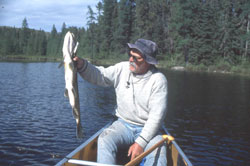
Techniques
No trolling motors (batteries are heavy and there is no way to recharge them). No metal flake bass boats. For me, part of the attraction of Quetico Park fishing is that it is very much like the fishing I learned from Dad – 60 years ago in northern Michigan.
Trolling is a very productive method for Quetico pike. Trolling, in this sense, is not merely dragging lures behind a canoe and hoping something grabs on. Troll parallel to the spine of humps, points and islands. Use lures that complement one another. The angler trolling toward shore should use a lure that runs shallower than the angler trolling away from shore, a perspective I learned from Dad. The lures should be at optimal action at the same speed. Dad used to ask me, “Are you getting the wiggle?” What he meant to determine was whether my lure was vibrating as it ought or was he running the boat too fast or two slow. Both anglers’ lures should “get the wiggle.” Deep running lures are ideal for finding humps or the spine of points; a lure that has been running free and suddenly hits something has found a hump. Start trolling close to shore and move gradually deeper with changes in lures to match. On McDougall Lake, I found one of my favorite spots in Quetico Park by following a path slightly deeper than the canoe of friends ahead of me. Using just such a technique, Doug Shafer and I headed back to camp one evening when Doug announced he was hung on the bottom. No way, Doug, your lure was not running deep enough to hit the bottom. Sure enough, Doug had a 38-inch pike attached to the business end of his rig. It was a much larger fish than Doug had ever seen (outside an aquarium), let alone caught. Drifting and paddling is the other principal means of fishing in the Quetico wilderness. While the wind in Quetico is fickle, as is true of wind wherever anglers ply their trade, most days, routes can be laid out that parallel as least some of the likely looking banks or islands. Often two anglers can work a productive stretch casting with only a few paddle strokes from time-to-time.
In 2008, Quetico Park adopted a barbless hook policy. While officials have not mandated that all hooks must be barbless when you enter the Park, once tied on line, the hooks must be mashed down. And no natural bait or organic bait.
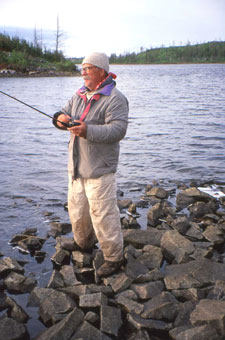
The lakes
Pike are widely dispersed throughout Quetico Park. I have not fished all the lakes in the Park, by a long shot. In the area of the Park known as Hunter Island, however, I’ve been on many. Among the best pike lakes I have visited are Suzanette, Alice, McKenzie, Basswood, McIntyre, Kawnipi, Yum Yum, Blackstone and Burt. Consider also the possibility of bushwhacking into lakes without portage trails. While bushwhacking is hard work, Pierna, Swartman and an unnamed lake just off Fauquier (I’m not trying to be secretive here – the maps do not ascribe a name to this lake) have yielded great pike fishing.
The gear
What to take? Whatever you are willing to carry. In 2008 I passed a party, at least two days portaging and paddlinginto the Park, that had one of the collapsible kitchens set up under a tarp. That’s heavier and more bulky than I want to lug into the bush, but to each his own. Ultra-light camping gear is a necessity. A reliable outfitter can supply a list of required camping gear. Fishing gear, too, should be kept to a minimum. Either casting or spinning gear, depending on your preference, works for Quetico pike.
Sometimes I have taken a pike-suitable fly rod. Four times I have broken a rod, each time while the rod was lashed under the canoe thwarts. When heavy packs were taken out or put in a canoe, my rod became entangled with the pack. Now I take a rod I’m willing to break, an old 6-foot bait caster. The best way to carry rods is to tie them under the canoe thwarts, close to the edge of the canoe. If not tied down on the portage trails, the rods are simply one more loose item to get tangled with other gear or left behind. A fully-loaded tackle box is out of the question. I carry all my gear in a soft-sided tackle sack. The best pike lures include some jerkbaits, like Rogues or Thundersticks. Top-waters like Zara Spooks take shallow pike. Deep-running crankbaits like Bill Norman Deep N’s or Cotton Cordell’s Wally Diver fill the bill for deeper pike. Spoons like Red Eye or Dardevle always are pike attractors. These are my favorites and your favorites will likely work as well. I never carry a net. They are a nuisance in the canoe while not fishing. Over the years, in Quetico and elsewhere, I have hand-landed some pretty big pike – 20-pounds and above – by hand.
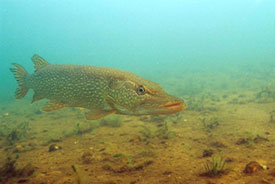
The other fish
Quetico Park is prime country for walleyes, smallmouth bass and lake trout, as well as pike. In some lakes there are also largemouth bass. Part of the attraction, for me at least, is that you never know what might grab on.
Certainly, I target pike. But when a 5-pound smallmouth or walleye latches on to my lure, I think that’s pretty neat as well. In 2008, Wayne Harrison was in my group and he caught a 31-inch walleye – a monster!
Outfitters
While you can save money by making all the arrangements yourself, an outfitter can take care of many details. There are numerous access points to Quetico Park. In the US, Ely and Orr, Minnesota are the principal ones. The Chamber of Commerce in Ely can make suggestions. Contact www.ely.org.
Access to Quetico Park is restricted. You need a permit to enter the Park and to camp. An outfitter can help gain a permit. You will also require a Remote Area Border Crossing Permit (RABC). You must apply personally (not in person) for an RABC Permit. Search for Canada Border Services Agency, click on “forms” and download the required application for an RABC. It will take a month or more to get an RABC permit. Five to 6-months should be allowed to gain a Quetico Park permit.
Claim answered
Quetico Park is a special place for me. Part of the lure, no doubt about it, is pike fishing. Yet, I’m also attracted by the evening sunset over the forest (and the sunrise on the other side of the lake), the wail of the loons in the middle of the night, the silence, the absence of hustle-and-bustle, the opportunity to let the schedule pass unobserved. Sleeping on the ground and lugging canoes along portage trails is not for everyone. But it is for me. After Craig chastised me for failing to land his first Quetico pike, I told him we’d catch more, perhaps even bigger. Craig made half a dozen trips with me. College, marriage, children and other obligations have intruded and prevented him from accompanying me these days. Yet, I made good my boast. Craig and I, and those who go with me now, have caught hundreds of Quetico pike, including genuine trophies. Green shadows that dart from under a massive log or rise unseen off a rocky outcropping to smash a lure. Enough to stir the blood of any pike angler. It’s worth a try. My next permit application is already in the mail.










